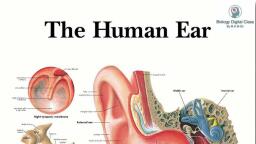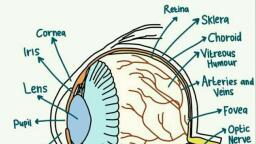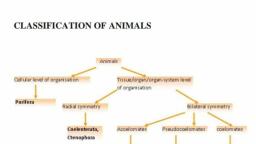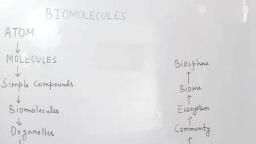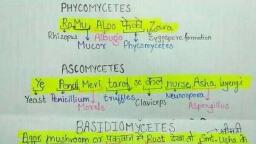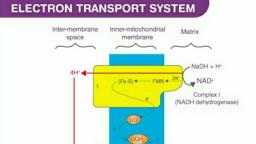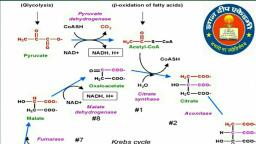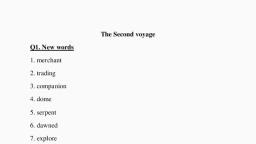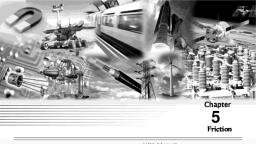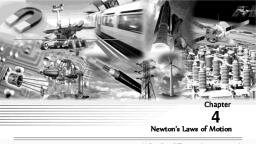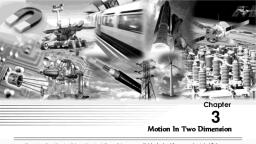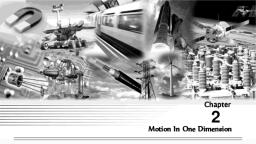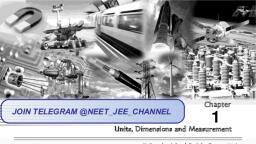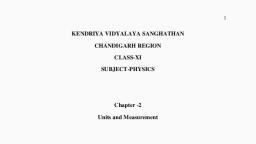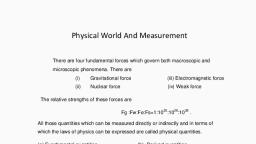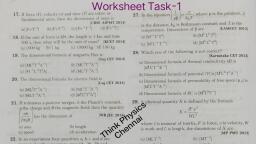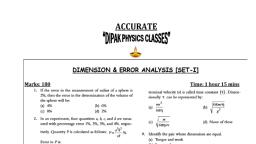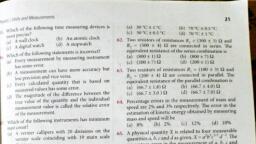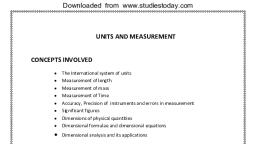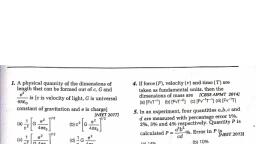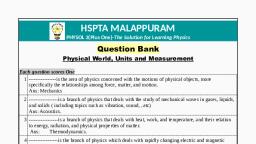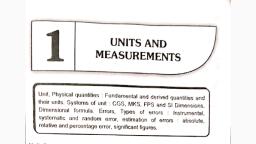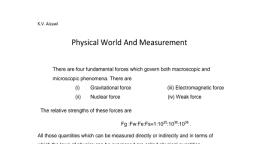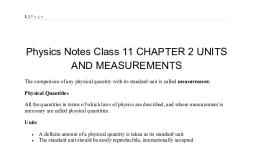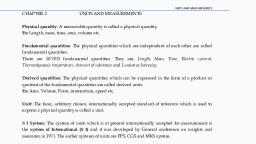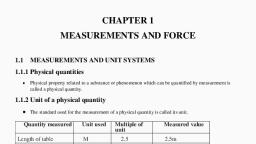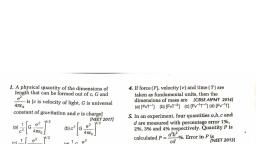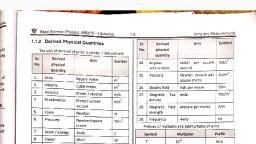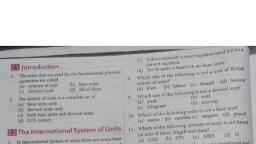Page 1 :
Units, Dimensions and Measurement 35, , Chapter, , 1, , Units, Dimensions and Measurement, Physical Quantity, A quantity which can be measured and by which various physical, happenings can be explained and expressed in the form of laws is called a, physical quantity. For example length, mass, time, force etc., On the other hand various happenings in life e.g., happiness, sorrow, etc. are not physical quantities because these can not be measured., Measurement is necessary to determine magnitude of a physical, quantity, to compare two similar physical quantities and to prove physical, laws or equations., A physical quantity is represented completely by its magnitude and, unit. For example, 10 metre means a length which is ten times the unit of, length. Here 10 represents the numerical value of the given quantity and, metre represents the unit of quantity under consideration. Thus in, expressing a physical quantity we choose a unit and then find that how, many times that unit is contained in the given physical quantity, i.e., Physical quantity (Q) = Magnitude × Unit = n × u, Where, n represents the numerical value and u represents the unit., Thus while expressing definite amount of physical quantity, it is clear that, as the unit(u) changes, the magnitude(n) will also change but product ‘nu’, will remain same., , i.e. n u = constant,, , or n1u1 n2u2 constant ; n , , 1, u, , i.e. magnitude of a physical quantity and units are inversely, proportional to each other .Larger the unit, smaller will be the magnitude., (1) Ratio (numerical value only) : When a physical quantity is the, ratio of two similar quantities, it has no unit., e.g. Relative density = Density of object/Density of water at 4 C, , (3) Vector (magnitude and direction) : These quantities have, magnitude and direction both and can be added or subtracted with the help, of laws of vector algebra e.g. displacement, velocity, acceleration, force etc., , Fundamental and Derived Quantities, (1) Fundamental quantities : Out of large number of physical, quantities which exist in nature, there are only few quantities which are, independent of all other quantities and do not require the help of any other, physical quantity for their definition, therefore these are called absolute, quantities. These quantities are also called fundamental or basic quantities,, as all other quantities are based upon and can be expressed in terms of, these quantities., (2) Derived quantities : All other physical quantities can be derived by, suitable multiplication or division of different powers of fundamental, quantities. These are therefore called derived quantities., If length is defined as a fundamental quantity then area and volume, are derived from length and are expressed in term of length with power 2, and 3 over the term of length., , Note : In mechanics, Length, Mass and Time are arbitrarily, chosen as fundamental quantities. However this set of fundamental, quantities is not a unique choice. In fact any three quantities in mechanics, can be termed as fundamental as all other quantities in mechanics can be, expressed in terms of these. e.g. if speed and time are taken as fundamental, quantities, length will become a derived quantity because then length will be, expressed as Speed Time. and if force and acceleration are taken as, fundamental quantities, then mass will be defined as Force / acceleration, and will be termed as a derived quantity., , Fundamental and Derived Units, , o, , Refractive index = Velocity of light in air/Velocity of light in medium, Strain = Change in dimension/Original dimension, (2) Scalar (magnitude only) : These quantities do not have any, direction e.g. Length, time, work, energy etc., Magnitude of a physical quantity can be negative. In that case, negative sign indicates that the numerical value of the quantity under, consideration is negative. It does not specify the direction., Scalar quantities can be added or subtracted with the help of ordinary, laws of addition or subtraction., , Normally each physical quantity requires a unit or standard for its, specification so it appears that there must be as many units as there are, physical quantities. However, it is not so. It has been found that if in, mechanics we choose arbitrarily units of any three physical quantities we, can express the units of all other physical quantities in mechanics in terms, of these. Arbitrarily the physical quantities mass, length and time are chosen, for this purpose. So any unit of mass, length and time in mechanics is called, a fundamental, absolute or base unit. Other units which can be expressed in, terms of fundamental units, are called derived units. For example light year, or km is a fundamental unit as it is a unit of length while s , m or kg/m are, derived units as these are derived from units of time, mass and length., –1, , 2
Page 2 :
System of units : A complete set of units, both fundamental and, derived for all kinds of physical quantities is called system of units. The, common systems are given below, , 103, , kilo, , k, , 102, , hecto, , h, , (1) CGS system : This system is also called Gaussian system of units., In this length, mass and time have been chosen as the fundamental, quantities and corresponding fundamental units are centimetre (cm), gram, (g) and second (s) respectively., , 101, , deca, , da, , –1, , deci, , d, , –2, , centi, , c, , 10, , –3, , milli, , m, , 10, , –6, , micro, , , , 10, , –9, , nano, , n, , 10, , –12, , pico, , p, , 10, , –15, , femto, , f, , –18, , atto, , a, , 10, 10, , (2) MKS system : This system is also called Giorgi system. In this, system also length, mass and time have been taken as fundamental, quantities, and the corresponding fundamental units are metre, kilogram, and second., (3) FPS system : In this system foot, pound and second are used, respectively for measurements of length, mass and time. In this system force, is a derived quantity with unit poundal., (4) S. I. system : It is known as International system of units, and is, extended system of units applied to whole physics. There are seven, fundamental quantities in this system. These quantities and their units are, given in the following table, Table 1.1 : Unit and symbol of quantities, Quantity, , Unit, , Symbol, , Length, , metre, , m, , kilogram, , kg, , Mass, Time, , second, , s, , Electric Current, , ampere, , A, , Temperature, , Kelvin, , K, , Amount of Substance, , mole, , mol, , 10, , Standards of Length, Mass and Time, (1) Length : Standard metre is defined in terms of wavelength of, light and is called atomic standard of length., The metre is the distance containing 1650763.73 wavelength in, vacuum of the radiation corresponding to orange red light emitted by an, atom of krypton-86., Now a days metre is defined as length of the path travelled by light, in vacuum in 1/299,7792, 45 part of a second., (2) Mass : The mass of a cylinder made of platinum-iridium alloy, kept at International Bureau of Weights and Measures is defined as 1 kg., On atomic scale, 1 kilogram is equivalent to the mass of 5.0188 10, atoms of C (an isotope of carbon)., (3) Time : 1 second is defined as the time interval of 9192631770, vibrations of radiation in Cs-133 atom. This radiation corresponds to the, transition between two hyperfine level of the ground state of Cs-133., , 25, , 12, , Luminous Intensity, , cd, , candela, , 6, , Besides the above seven fundamental units two supplementary units, are also defined –, , Practical Units, , Radian (rad) for plane angle and Steradian (sr) for solid angle., , (1) Length, (i) 1 fermi = 1 fm = 10 m, (ii) 1 X-ray unit = 1XU = 10 m, , Note : Apart from fundamental and derived units we also use, , –15, , practical units very frequently. These may be fundamental or derived units, e.g., light year is a practical unit (fundamental) of distance while horse power is a, practical unit (derived) of power., , –13, , (iii) 1 angstrom = 1Å = 10 m = 10 cm = 10 mm = 0.1 mm, –10, , –8, , –7, , (iv) 1 micron = m = 10 m, , Practical units may or may not belong to a system but can be, , –6, , expressed in any system of units, e.g., 1 mile = 1.6 km = 1.6 × 10 m., , (v) 1 astronomical unit = 1 A.U. = 1. 49 10 m, , S.I. Prefixes, , (vi) 1 Light year = 1 ly = 9.46 10 m, (vii) 1 Parsec = 1pc = 3.26 light year, (2) Mass, (i) Chandra Shekhar unit : 1 CSU = 1.4 times the mass of sun = 2.8 , , 11, , 1.5 10 m 10 km, , 3, , 11, , In physics we deal from very small ( micro ) to very large, (macro ) magnitudes, as one side we talk about the atom while on the, other side of universe, e.g., the mass of an electron is 9.1 10 kg, while that of the sun is 2 10 kg . To express such large or small, magnitudes we use the following prefixes :, –3 1, , 30, , Table 1.2 : Prefixes and symbol, Power of 10, , 8, , 15, , 10 kg, 30, , (ii) Metric tonne : 1 Metric tonne = 1000 kg, (iii) Quintal : 1 Quintal = 100 kg, (iv) Atomic mass unit (amu) : amu = 1.67 10 kg, Mass of proton or neutron is of the order of 1 amu, (3) Time, (i) Year : It is the time taken by the Earth to complete 1 revolution, around the Sun in its orbit., (ii) Lunar month : It is the time taken by the Moon to complete 1, revolution around the Earth in its orbit., 1 L.M. = 27.3 days, –27, , Prefix, , Symbol, , 10, , 18, , exa, , E, , 10, , 15, , peta, , P, , 10, , 12, , tera, , T, , 10, , 9, , giga, , G, , 10, , 6, , mega, , M
Page 3 :
Units, Dimensions and Measurement 37, (iii) Solar day : It is the time taken by Earth to complete one, rotation about its axis with respect to Sun. Since this time varies from day, to day, average solar day is calculated by taking average of the duration of, all the days in a year and this is called Average Solar day., 1 Solar year = 365.25 average solar day, 1, or average solar day , the part of solar year, 365.25, (iv) Sedrial day : It is the time taken by earth to complete one rotation, about its axis with respect to a distant star., 1 Solar year = 366.25 Sedrial day, = 365.25 average solar day, Thus 1 Sedrial day is less than 1 solar day., (v) Shake : It is an obsolete and practical unit of time., 1 Shake = 10 sec, , [M L T ], , Strain, refractive index, relative density, angle, solid, angle, distance gradient, relative permittivity, (dielectric constant), relative permeability etc., , [M L T ], , Latent heat and gravitational potential, , 0, , 0, , 0, , 2, , 0, , –2, , [ML T ], 2, , –2, , –1, , l g , m k , R g , where l = length, , [M L T ], 0, , 0, , 1, , g = acceleration due to gravity, m = mass,, spring constant, R = Radius of earth, L/R,, , LC , RC where L = inductance,, resistance, C = capacitance, , [M L T ], 0, , 0, , 1, , –8, , Dimensions, When a derived quantity is expressed in terms of fundamental, quantities, it is written as a product of different powers of the fundamental, quantities. The powers to which fundamental quantities must be raised in, order to express the given physical quantity are called its dimensions., To make it more clear, consider the physical quantity force, Force = mass × acceleration, , Thermal capacity, gas constant, Boltzmann constant, and entropy, , k =, , R=, , V2, q2, t, VIt, qV , LI 2 ,, , CV 2 where I =, R, C, current, t = time, q = charge,, I 2 Rt,, , [ML T ], 2, , –2, , L = inductance, C = capacitance, R = resistance, , Important Dimensions of Complete Physics, , mass velocity, , time, , Heat, , mass length/time, time, = mass × length × (time), … (i), Thus, the dimensions of force are 1 in mass, 1 in length and – 2 in, , , Quantity, , Unit, , Dimension, , Temperature (T), , Kelvin, , [M L T ], , Heat (Q), , Joule, , [ML T ], , Specific Heat (c), , Joule/kg-K, , [M L T ], , Here the physical quantity that is expressed in terms of the basic, quantities is enclosed in square brackets to indicate that the equation is, among the dimensions and not among the magnitudes., Thus equation (i) can be written as [force] = [MLT ]., Such an expression for a physical quantity in terms of the, fundamental quantities is called the dimensional equation. If we consider, only the R.H.S. of the equation, the expression is termed as dimensional, formula., Thus, dimensional formula for force is, [MLT ]., , Thermal capacity, , Joule/K, , [M L T ], , Latent heat (L), , Joule/kg, , [M L T ], , Gas constant (R), , Joule/mol-K, , [M L T ], , Boltzmann constant (k), , Joule/K, , [M L T ], , Coefficient of thermal, conductivity (K), , Joule/m-s-K, , [M L T ], , Stefan's constant (), , Watt/m -K, , [M L T ], , Quantities Having same Dimensions, , Wien's constant (b), , Metre-K, , [M L T ], , Planck's constant (h), Coefficient of Linear Expansion, (), Mechanical equivalent of Heat, (J), Vander wall’s constant (a), Vander wall’s constant (b), , Joule-s, , [M L T ], , Kelvin, , [M L T ], , Joule/Calorie, , [M L T ], , Newton-m, m, , [ML T ], , –2, , time., , 0, , 0, , 2, , 0, , 1, , 1, , –2, , 2, , –2, , 2, , 0, , 1, , 0, , –1, , –2, , 2, , 2, , –1, , –2, , –2, , –1, , –2, , –2, , Dimension, [M L T ], 0, , 0, , –1, , [M L T ], 1, , 2, , –2, , Quantity, Frequency, angular frequency, angular velocity,, velocity gradient and decay constant, Work, internal energy, potential energy, kinetic, energy, torque, moment of force, , [M L T ], , Pressure, stress, Young’s modulus, bulk modulus,, modulus of rigidity, energy density, , [M L T ], , Momentum, impulse, , Quantity, , [M L T ], , Acceleration due to gravity, gravitational field, intensity, , Electric charge (q), Electric current (I), Capacitance (C), , 1, , 1, , –1, , 1, , 0, , –2, , –1, , 1, , –2, , [M L T ], 1, , 1, , –2, , Thrust, force, weight, energy gradient, , [M L T ], , Angular momentum and Planck’s constant, , [M L T ], , Surface tension, Surface energy (energy per unit, area), , 1, , 1, , 2, , 0, , –1, , –2, , 1, , 2, , 4, , 1, , 1, , 2, , 1, , –1, , 1, , 4, , 3, , –4, , 0, , 1, , –1, , 0, , 0, , –1, , –3, , 2, , 0, , –1, , –3, , 0, , 0, , 1, , –2, , 0, , 5, , 0, , –1, , 0, , –2, , [M L T ], 0, , 3, , 0, , Electricity, Unit, , Dimension, , Electric potential (V), , Coulomb, Ampere, Coulomb/volt or Farad, Joule/coulomb, , [M L T A ], [M L T A ], [M L T A ], [M L T A ], , Permittivity of free, space ( ), , Coulomb 2, Newton - metre 2, , [M L T A ], , Dielectric constant (K), Resistance (R), , Unitless, , 0, , Volt/Ampere or ohm, , 0, , 0, , 1, , 0, , 0, , 0, , –1, , –2, , 1, , 2, , –1, , 1, , 1, , 4, , –3, , –3, , 2, , –1, , 4, , 2, , [M L T ], [M L T A ], 0, , 0, , 0, , 1, , 2, , –3, , –2
Page 4 :
38 Units, Dimensions and Measurement, Quantity, , Unit, , Resistivity or Specific, resistance (), Coefficient of Selfinduction (L), Magnetic flux (), , Magnetic induction (B), , (i) Gravitational constant : According to Newton’s law of gravitation, , Dimension, , Ohm-metre, , [M L T A ], , volt second, or henry, ampere, , [M L T A ], , or ohm-second, Volt-second or weber, , [M L T A ], , 1, , 1, , –3, , 2, , –2, , –2, , FG, , –2, , 2, , –2, , 1, , 0, , –2, , –1, , [h] , , [M L T A ], 0, , –1, , 0, , [M L T A ], 0, , 2, , 2, , [T 1 ], , [ML2 T 1 ], , (iii) Coefficient of viscosity : According to Poiseuille’s formula, , 0, , 1, , pr 4, dV pr 4, or , , dt, 8l, 8 l(dV / dt), Substituting, , Volt second, or, ampere metre, , [] , , 1, , [ML T, , 2, , the, 4, , ][L ], , 3, , dimensions, , of, , all, , physical, , quantities, , [ML1 T 1 ], , [L][L / T ], , [M L T A ], 1, , 1, , –2, , –2, , (3) To convert a physical quantity from one system to the other : The, measure of a physical quantity is nu = constant, If a physical quantity X has dimensional formula [M L T ] and if, a, , Ohm sec ond, metre, , or, , [ML2 T 2 ], , 1, , Joule, or, ampere 2 metre, , 0, , , , Substituting the dimensions of all physical quantities, , [M L T A ], , 2, , Newton, ampere 2, , Permeability of Free, Space ( ), , E, , (ii) Plank constant : According to Planck E h or h , , Ampere/metre, Ampere-metre, , [MLT 2 ][L2 ], [M 1 L3 T 2 ], [M ][M ], , –1, , volt second, or Tesla, metre 2, , Magnetic Intensity (H), Magnetic Dipole, Moment (M), , Fr 2, m 1m 2, or G , 2, m1m 2, r, Substituting the dimensions of all physical quantities, , [G] , 1, , newton, ampere metre, Joule, , ampere metre, , 3, , b, , c, , (derived) units of that physical quantity in two systems are [M 1a Lb1 T1c ], and [M 2a Lb2 T2c ] respectively and n and n be the numerical values in the, 1, , henry, or, metre, , 2, , two systems respectively, then n1 [u1 ] n 2 [u 2 ], , Surface charge density, (), Electric dipole moment, (p), Conductance (G) (1/R), Conductivity () (1/), , ohm 1metre 1, , [M L T A ], , Current density (J), Intensity of electric, field (E), Rydberg constant (R), , Ampere/m, Volt/metre,, Newton/coulomb, m, , ML TA, , Coulomb metre 2, , [M L T A ], , n1 [M 1a Lb1 T1c ] n 2 [M 2a Lb2 T2c ], , Coulomb metre, , [M L T A ], , ohm 1, , [M L T A ], , M L T , n 2 n1 1 1 1 , M 2 L 2 T2 , , 0, , –2, , 0, , 1, , 1, , –1, , 1, , –2, , –1, , 1, , 3, , –3, , a, , 1, , 2, , 3, , 2, , –2, , 0, , 1, , 1, , 1, , –3, , –1, , ML T, 0, , –1, , –1, , 1, , 1, , 2, , MLT A, 0, , c, , where M , L and T are fundamental units of mass, length and time, in the first (known) system and M , L and T are fundamental units of mass,, length and time in the second (unknown) system. Thus knowing the values, of fundamental units in two systems and numerical value in one system, the, numerical value in other system may be evaluated., 1, , 0, , 2, , b, , 2, , 2, , Example : (i) conversion of Newton into Dyne., , Application of Dimensional Analysis, (1) To find the unit of a physical quantity in a given system of units, : To write the definition or formula for the physical quantity we find its, dimensions. Now in the dimensional formula replacing M, L and T by the, fundamental units of the required system we get the unit of physical, quantity. However, sometimes to this unit we further assign a specific name,, , The Newton is the S.I. unit of force and has dimensional formula, [MLT ]., –2, , So 1 N = 1 kg-m/ sec, , a, , 1, , 2, , –2, , So its unit in C.G.S. system will be g cm /s which is called erg while, in M.K.S. system will be kg-m /s which is called joule., 2, , 2, , 1, , kg m sec , 1, , , gm cm sec , , So [W] = [MLT ] [L] = [ML T ], 2, , 2, , 10 3 gm , 1, , gm , , (2) To find dimensions of physical constant or coefficients : As, dimensions of a physical quantity are unique, we write any formula or, equation incorporating the given constant and then by substituting the, dimensional formulae of all other quantities, we can find the dimensions of, the required constant or coefficient., , b, , M L T , n 2 n1 1 1 1 , M 2 L 2 T2 , , By using, , e.g., Work = Force Displacement, –2, , 2, , 1, , c, , 2, , 1, , 10 2 cm sec 2, 5, , , 10, cm sec , , 1 N = 10 Dyne, 5, , (ii) Conversion of gravitational constant (G) from C.G.S. to M.K.S., system
Page 5 :
Units, Dimensions and Measurement 39, The value of G in C.G.S. system is 6.67 10 C.G.S. units while its, dimensional formula is [M L T ], –8, , –1, , 3, , –2, , If the above relation is dimensionally correct then by substituting, the dimensions of quantities –, [T] = [M] [L] [LT ], , So G = 6.67 10 cm /g s, –8, , 3, , x, , 2, , a, , b, , M L T , By using n 2 n1 1 1 1 , M 2 L 2 T2 , gm , 6 .67 10 8 , , kg , , 6 .67 10, , 6.67 10, , 1, , 3, , cm sec , m sec , , , , c, , 1, , 11, , G = 6.67 10 M.K.S. units, –11, , (4) To check the dimensional correctness of a given physical relation, : This is based on the ‘principle of homogeneity’. According to this principle, the dimensions of each term on both sides of an equation must be the, same., If X A (BC)2 DEF ,, , –2, , z, , or, , [M L T ] = [M L T ], 0, , 0, , 1, , x, , y+z, , –2 z, , Equating the exponents of similar quantities x = 0, y = 1/2 and z = –, 1/2, So the required physical relation becomes T K, , 2, , 3, 2, gm cm sec , 3, 2 , , 10 gm 10 cm sec , , 8 , , y, , l, g, , The value of dimensionless constant is found (2 ) through, experiments so T 2, , l, g, , (ii) Stoke’s law : When a small sphere moves at low speed through a, fluid, the viscous force F, opposes the motion, is found experimentally to, depend on the radius r, the velocity of the sphere v and the viscosity of, the fluid., So F = f (, r, v), If the function is product of power functions of , r and v,, , F K x r y v z ; where K is dimensionless constant., If the above relation is dimensionally correct, , then according to principle of homogeneity, , [MLT 2 ] [ML1T 1 ]x [L]y [LT 1 ]z, , [X] = [A] = [(BC) ] [ DEF], 2, , or [MLT 2 ] [M x L x y z T x z ], , If the dimensions of each term on both sides are same, the equation, is dimensionally correct, otherwise not. A dimensionally correct equation, may or may not be physically correct., , Equating the exponents of similar quantities, , x = 1; – x + y + z = 1 and – x – z = – 2, , Example : (i) F mv 2 / r 2, , Solving these for x, y and z, we get x = y = z = 1, , By substituting dimension of the physical quantities in the above, , So equation (i) becomes, , relation, [MLT 2 ] [M ][LT 1 ]2 /[L]2, , i.e. [MLT, , 2, , ] [MT, , 2, , On experimental grounds, K = 6; so F = 6rv, , ], , As in the above equation dimensions of both sides are not same; this, formula is not correct dimensionally, so can never be physically., , F = Krv, , This is the famous Stoke’s law., , Limitations of Dimensional Analysis, Although dimensional analysis is very useful it cannot lead us too far, , (ii) s ut (1 / 2)at 2, , as,, , By substituting dimension of the physical quantities in the above, relation, [L] = [LT ][T] – [LT ][T ], –1, , –2, , 2, , i.e. [L] = [L] – [L], , (1) If dimensions are given, physical quantity may not be unique as, many physical quantities have same dimensions. For example if the, dimensional formula of a physical quantity is [ML2 T 2 ] it may be work or, energy or torque., , As in the above equation dimensions of each term on both sides are, same, so this equation is dimensionally correct. However, from equations of, , (2) Numerical constant having no dimensions [K] such as (1/2), 1 or, 2 etc. cannot be deduced by the methods of dimensions., , motion we know that s ut (1 / 2)at 2, , (3) The method of dimensions can not be used to derive relations, other than product of power functions. For example,, , (5) As a research tool to derive new relations : If one knows the, dependency of a physical quantity on other quantities and if the dependency, is of the product type, then using the method of dimensional analysis,, relation between the quantities can be derived., , Example : (i) Time period of a simple pendulum., Let time period of a simple pendulum is a function of mass of the bob, (m), effective length (l), acceleration due to gravity (g) then assuming the, function to be product of power function of m, l and g, , i.e., T Km x l y g z ; where K = dimensionless constant, , s u t (1 / 2) a t 2 or y a sin t, , cannot be derived by using this theory (try if you can). However, the, dimensional correctness of these can be checked., (4) The method of dimensions cannot be applied to derive formula, if in mechanics a physical quantity depends on more than 3 physical, quantities as then there will be less number (= 3) of equations than the, unknowns (>3). However still we can check correctness of the given, equation dimensionally. For example T 2 I mgl can not be derived by, theory of dimensions but its dimensional correctness can be checked.
Page 6 :
40 Units, Dimensions and Measurement, (5) Even if a physical quantity depends on 3 physical quantities, out, of which two have same dimensions, the formula cannot be derived by, theory of dimensions, e.g., formula for the frequency of a tuning fork, f (d / L2 ) v cannot be derived by theory of dimensions but can be, checked., , Significant Figures, Significant figures in the measured value of a physical quantity tell, the number of digits in which we have confidence. Larger the number of, significant figures obtained in a measurement, greater is the accuracy of the, measurement. The reverse is also true., The following rules are observed in counting the number of, significant figures in a given measured quantity., (1) All non-zero digits are significant., Example : 42.3 has three significant figures., 243.4 has four significant figures., 24.123 has five significant figures., (2) A zero becomes significant figure if it appears between two nonzero digits., , Example : x = 3.250 becomes 3.2 on rounding off,, again x = 12.650 becomes 12.6 on rounding off., (5) If digit to be dropped is 5 or 5 followed by zeros, then the, preceding digit is raised by one, if it is odd., Example : x = 3.750 is rounded off to 3.8,, again x = 16.150 is rounded off to 16.2., , Significant Figures in Calculation, In most of the experiments, the observations of various, measurements are to be combined mathematically, i.e., added, subtracted,, multiplied or divided to achieve the final result. Since, all the observations in, measurements do not have the same precision, it is natural that the final, result cannot be more precise than the least precise measurement. The, following two rules should be followed to obtain the proper number of, significant figures in any calculation., (1) The result of an addition or subtraction in the number having, different precisions should be reported to the same number of decimal places, as present in the number having the least number of decimal places. The rule, is illustrated by the following examples :, 33.3 (has only one decimal place), , (i), , 3.11, + 0.313, , Example : 5.03 has three significant figures., 5.604 has four significant figures., , 36.723, , 4.004 has four significant figures., , one decimal place), , (3) Leading zeros or the zeros placed to the left of the number are, never significant., , Example : 0.543 has three significant figures., , (ii), , Answer = 36.7, 3.1421, 0.241, , 0.045 has two significant figures., , (has 2 decimal places), , + 0.09, , 0.006 has one significant figure., , 3.4731, , (4) Trailing zeros or the zeros placed to the right of the number are, significant., , (answer should be reported, to 2 decimal places), , Example : 4.330 has four significant figures., 433.00 has five significant figures., , (answer should be reported to, , Answer = 3.47, (iii), , 62.831, , 343.000 has six significant figures., , –, , (5) In exponential notation, the numerical portion gives the number, of significant figures., , 38.2818, , (has 3 decimal places), 24.5492, (answer should be reported to 3, decimal places after rounding off), , Example : 1.32 10 has three significant figures., –2, , 1.32 10 has three significant figures., , Answer = 38.282, , 4, , Rounding Off, While rounding off measurements, we use the following rules by, convention:, , (2) The answer to a multiplication or division is rounded off to the, same number of significant figures as possessed by the least precise term, used in the calculation. The rule is illustrated by the following examples :, (i), , 142.06, 0.23, , (1) If the digit to be dropped is less than 5, then the preceding digit, is left unchanged., , 32.6738 (answer should have two, , Example : x 7.82 is rounded off to 7.8,, again x 3.94 is rounded off to 3.9., (2) If the digit to be dropped is more than 5, then the preceding, digit is raised by one., Example : x = 6.87 is rounded off to 6.9,, again x = 12.78 is rounded off to 12.8., (3) If the digit to be dropped is 5 followed by digits other than zero,, then the preceding digit is raised by one., Example : x = 16.351 is rounded off to 16.4,, again x = 6.758 is rounded off to 6.8., (4) If digit to be dropped is 5 or 5 followed by zeros, then preceding, digit is left unchanged, if it is even., , (two significant figures), significant figures), , Answer = 33, (ii), , 51.028, , , 1.31, , (three significant figures), , 66.84668, Answer = 66.8, (iii), , 0 .90, 0 .2112676, 4 .26, , Answer = 0.21
Page 7 :
Units, Dimensions and Measurement 41, , Order of Magnitude, In scientific notation the numbers are expressed as, Number, M 10 x . Where M is a number lies between 1 and 10 and x is integer., Order of magnitude of quantity is the power of 10 required to represent the, quantity. For determining this power, the value of the quantity has to be, rounded off. While rounding off, we ignore the last digit which is less than, 5. If the last digit is 5 or more than five, the preceding digit is increased by, one. For example,, (1) Speed of light in vacuum, , 3 10 8 ms 1 10 8 m / s, , (ignoring 3 < 5), , (2) Mass of electron 9.1 10 31 kg 10 30 kg (as 9.1 > 5)., , Errors of Measurement, The measuring process is essentially a process of comparison. Inspite, of our best efforts, the measured value of a quantity is always somewhat, different from its actual value, or true value. This difference in the true, value and measured value of a quantity is called error of measurement., (1) Absolute error : Absolute error in the measurement of a physical, quantity is the magnitude of the difference between the true value and the, measured value of the quantity., Let a physical quantity be measured n times. Let the measured value, be a , a , a , ….. a . The arithmetic mean of these value is, a a2 ...... an, am 1, n, Usually, a is taken as the true value of the quantity, if the same is, unknown otherwise., By definition, absolute errors in the measured values of the quantity, are, 1, , 2, , n, , 3, , m, , a1 am a1, , a2 am a2, , …………., an am an, , The absolute errors may be positive in certain cases and negative in, certain other cases., (2) Mean absolute error : It is the arithmetic mean of the, magnitudes of absolute errors in all the measurements of the quantity. It is, represented by a. Thus, | a1 | | a2 | ..... | an |, a , n, Hence the final result of measurement may be written as, a am a, This implies that any measurement of the quantity is likely to lie, , between (am a) and (am a)., (3) Relative error or Fractional error : The relative error or, fractional error of measurement is defined as the ratio of mean absolute, error to the mean value of the quantity measured. Thus, Mean absolute error a, , Mean value, am, (4) Percentage error : When the relative/fractional error is expressed, in percentage, we call it percentage error. Thus, , x = absolute error in calculation of x, i.e. sum of a and b., The maximum absolute error in x is x (a b), (a b), 100%, ab, (2) Error in difference of the quantities : Suppose x = a – b, Let a = absolute error in measurement of a,, b = absolute error in measurement of b, x = absolute error in calculation of x i.e. difference of a and b., The maximum absolute error in x is x (a b), , Percentage error in the value of x , , Percentage error in the value of x , , (a b), 100%, ab, , (3) Error in product of quantities :, Suppose x = a b, Let a = absolute error in measurement of a,, b = absolute error in measurement of b, x = absolute error in calculation of x i.e. product of a and b., The maximum fractional error in x is, , x, a b , , , , x, b , a, , Percentage error in the value of x, = (% error in value of a) + (% error in value of b), (4) Error in division of quantities : Suppose x , , a, b, , Let a = absolute error in measurement of a,, b = absolute error in measurement of b, x = absolute error in calculation of x i.e. division of a and b., The maximum fractional error in x is, , x, a b , , , , x, b , a, , Percentage error in the value of x, = (% error in value of a) + (% error in value of b), (5) Error in quantity raised to some power : Suppose x , , an, bm, , Let a = absolute error in measurement of a,, b = absolute error in measurement of b, x = absolute error in calculation of x, The maximum fractional error in x is, , x, b , a, n, m, , x, b , a, , Percentage error in the value of x, = n (% error in value of a) + m (%error in value of b), , Relative error or Fractional error , , Percentage error , , a, 100%, am, , Propagation of Errors, (1) Error in sum of the quantities : Suppose x = a + b, Let a = absolute error in measurement of a, b = absolute error in measurement of b, , The standard of Weight and Measures Act was passed in India in, 1976. It recommended the use of SI in all fields of science, technology,, trade and industry., , The dimensions of many physical quantities, especially those in, heat, thermodynamics, electricity and magnetism in terms of mass,, length and time alone become irrational. Therefore, SI is adopted which, uses 7 basic units., , The dimensions of a physical quantity are the powers to which
Page 8 :
42 Units, Dimensions and Measurement, basic units (not fundamental units alone) should be raised to represent, the derived unit of that physical quantity., , A measurement of a physical quantity is said to be accurate if the, , physical quantity in terms of the basic units., , systematic error in its measurement is relatively very low. On the other, hand, the measurement of a physical quantity is said to be precise if the, random error is small., , The dimensions of a physical quantity do not depend on the system, , A measurement is most accurate if its observed value is very close, , The dimensional formula is very helpful in writing the unit of a, of units., , to the true value., , A physical quantity that does not have any unit must be, dimensionless., , The pure numbers are dimensionless., Generally, the symbols of those basic units, whose dimension, , Errors are always additive in nature., For greater accuracy, the quantity with higher power should have, least error., , (power) in the dimensional formula is zero, are omitted from the, dimensional formula., , The absolute error in each measurement is equal to the least count, , It is wrong to say that the dimensions of force are MLT . On the, , Percentage error = relative error × 100., , –2, , other hand we should say that the dimensional formula for force is MLT, and that the dimensions of force are 1 in mass, 1 in length and –2 in, time., , of the measuring instrument., , –2, , Physical quantities defined as the ratio of two similar quantities are, dimensionless., , The, , physical relation involving logarithm, exponential,, trigonometric ratios, numerical factors etc. cannot be derived by the, method of dimensional analysis., , Physical relations involving addition or subtraction sign cannot be, derived by the method of dimensional analysis., , If units or dimensions of two physical quantities are same, these, need not represent the same physical characteristics. For example torque, and work have the same units and dimensions but their physical, characteristics are different., , The standard units must not change with space and time. That is, why atomic standard of length and time have been defined. Attempts are, being made to define the atomic standard for mass as well., , The unit and dimensions of the absolute error are same as that of, quantity itself., , Absolute error is not dimensionless quantity., Relative error is dimensionless quantity., Least Count =, , value of 1 part on main scale (s), Number of parts on vernier scale (n), , Least count of vernier callipers, value of 1 part of value of 1 part of , = , , , main scale (s) vernie r scale (v), , Least count of vernier calliper = 1 MSD – 1 VSD, where MSD = Main Scale Division, , VSD = Vernier Scale Division, Pitch(p), No. of parts on circular scale (n), , The unit of time, the second, was initially defined in terms of the, , Least count of screw guaze =, , rotation of the earth around the sun as well as that about its own axis., This time standard is subjected to variation with time. Therefore, the, atomic standard of time has been defined., , Smaller the least count, higher is the accuracy of measurement., , Any repetitive phenomenon, such as an oscillating pendulum,, spinning of earth about its axis, etc can be used to measure time., , The product of numerical value of the physical quantity (n) and its, unit (U) remains constant., That is : nU = constant or nU = n U ., , Larger the number of significant figures after the decimal in a, measurement, higher is the accuracy of measurement., , Significant figures do not change if we measure a physical quantity, in different units., , Significant figures retained after mathematical operation (like, , quantity is called magnitude of the physical quantity., , addition, subtraction, multiplication and division) should be equal to the, minimum significant figures involved in any physical quantity in the, given operation., , Thus : Magnitude = nU, , Significant figures are the number of digits upto which we are sure, , Poiseuille (unit of viscosity) = pascal (unit of pressure) × second., , about their accuracy., , That is : Pl : Pa- s., , If a number is without a decimal and ends in one or more zeros,, , The unit of power of lens (dioptre) gives the ability of the lens to, , power of 10) nearest to the actual value of the quantity., , then all the zeros at the end of the number may not be significant. To, make the number of significant figures clear, it is suggested that the, number may be written in exponential form. For example 20300 may be, expressed as 203.00×10 , to suggest that all the zeros at the end of 20300, are significant., , Angle is exceptional physical quantity, which though is a ratio of, , 1 inch = 2.54 cm, , 1, , 1, , 2, , 2, , The product of numerical value (n) and unit (U) of a physical, , converge or diverge the rays refracted through it., , The order of magnitude of a quantity means its value (in suitable, , two similar physical quantities (angle = arc / radius) but still requires a, unit (degrees or radians) to specify it along with its numerical value., , Solid angle subtended at a point inside the closed surface is 4, steradian., , 2, , 1 foot = 12 inches = 30.48 cm = 0.3048 m, 1 mile = 5280 ft = 1.609 km, , 1 yard = 0.9144 m
Page 9 :
Units, Dimensions and Measurement 43, , 1 slug = 14.59 kg, 1 barn = 10 m, –28, , 2, , 1 liter = 10 cm = 10 m, 3, , 1 km/h =, , 3, , –3, , 3, , 5, m/s, 18, , 1 m/s = 3.6 km/h, , 1 g/cm = 1000 kg/m, 3, , 3, , 1 atm. = 76 cm of Hg = 1.013 × 10 N/m, 5, , 2, , 1 N/m = Pa (Pascal), 2, , When we add or subtract two measured quantities, the absolute, error in the final result is equal to the sum of the absolute errors in the, measured quantities., , When we multiply or divide two measured quantities, the relative, error in the final result is equal to the sum of the relative errors in the, measured quantities.

